初中英语教学法主要知识点全英文
初中英语所有知识点总结6篇
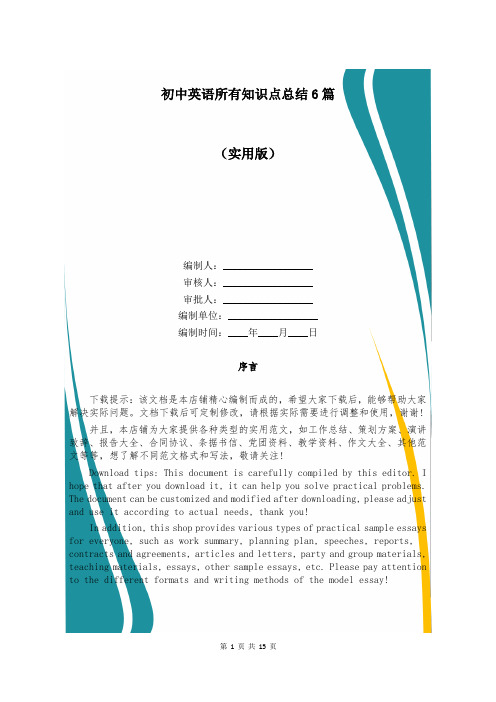
初中英语所有知识点总结6篇(实用版)编制人:__________________审核人:__________________审批人:__________________编制单位:__________________编制时间:____年____月____日序言下载提示:该文档是本店铺精心编制而成的,希望大家下载后,能够帮助大家解决实际问题。
文档下载后可定制修改,请根据实际需要进行调整和使用,谢谢!并且,本店铺为大家提供各种类型的实用范文,如工作总结、策划方案、演讲致辞、报告大全、合同协议、条据书信、党团资料、教学资料、作文大全、其他范文等等,想了解不同范文格式和写法,敬请关注!Download tips: This document is carefully compiled by this editor. I hope that after you download it, it can help you solve practical problems. The document can be customized and modified after downloading, please adjust and use it according to actual needs, thank you!In addition, this shop provides various types of practical sample essays for everyone, such as work summary, planning plan, speeches, reports, contracts and agreements, articles and letters, party and group materials, teaching materials, essays, other sample essays, etc. Please pay attention to the different formats and writing methods of the model essay!初中英语所有知识点总结6篇我们在阅读书籍或文章时,遇到文中精彩的部分或好词佳句和自己的心得、体会,随时随地把它写下来的一种文体。
初中英语各年级知识点总结
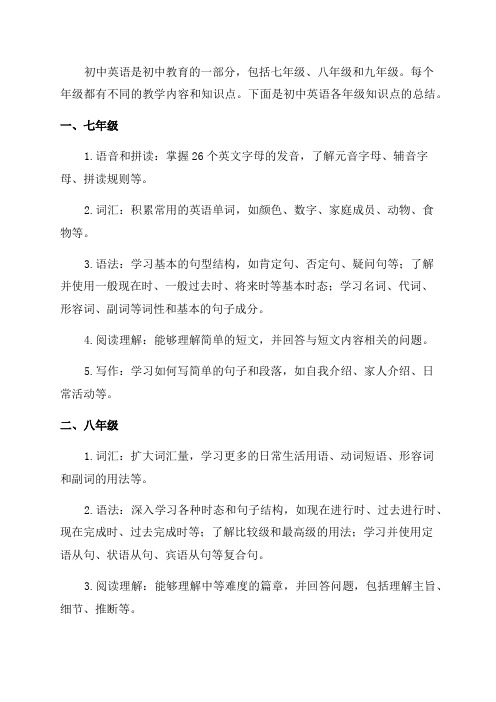
初中英语是初中教育的一部分,包括七年级、八年级和九年级。
每个年级都有不同的教学内容和知识点。
下面是初中英语各年级知识点的总结。
一、七年级1.语音和拼读:掌握26个英文字母的发音,了解元音字母、辅音字母、拼读规则等。
2.词汇:积累常用的英语单词,如颜色、数字、家庭成员、动物、食物等。
3.语法:学习基本的句型结构,如肯定句、否定句、疑问句等;了解并使用一般现在时、一般过去时、将来时等基本时态;学习名词、代词、形容词、副词等词性和基本的句子成分。
4.阅读理解:能够理解简单的短文,并回答与短文内容相关的问题。
5.写作:学习如何写简单的句子和段落,如自我介绍、家人介绍、日常活动等。
二、八年级1.词汇:扩大词汇量,学习更多的日常生活用语、动词短语、形容词和副词的用法等。
2.语法:深入学习各种时态和句子结构,如现在进行时、过去进行时、现在完成时、过去完成时等;了解比较级和最高级的用法;学习并使用定语从句、状语从句、宾语从句等复合句。
3.阅读理解:能够理解中等难度的篇章,并回答问题,包括理解主旨、细节、推断等。
4.写作:学习如何写描述性和叙事性的文章,包括日记、介绍人物、写旅行经历等。
5.口语表达:练习口语能力,学习如何进行简单的对话和交流,包括问路、购物、预订餐厅等。
三、九年级1.词汇:扩展词汇量,学习更多的学术用语和高级表达方式。
2.语法:深入学习各种句子结构的用法和特点,如虚拟语气、倒装句、强调句等;了解并使用宾语从句、表语从句、同位语从句等复合句型。
4.写作:学习如何写议论文、说明文、应用文等,包括提出问题、分析问题、提出解决方案等。
5.口语表达:练习口语能力,学习如何进行辩论和演讲,并能够表达自己的观点和意见。
(完整版)英语教学法知识点整理

1,Structural view of language sees languages as a linguistic system made up of various subsystems(Larsen-Freeman&Long): Phonology, morphology, syntax.语言的结构观把语言看作是由各种子系统组成的语言系统(弗里曼 &朗):音位学、形态学、句法。
2,Functional view: communicative needs of the learner (Johnson and Marrow ), the functional view not only sees languages as a linguistic system but also a means for doing things. Most of our day-to-day language use involves functional activities: offering, suggesting, advising, and apologizing.功能观:学习者的交际需求(约翰逊和马罗),功能观不但把语言看作一种语言系统,而且把语言看作一种做事的手段。
我们平常使用的大部分语言都涉及功能性活动:供应、建讲和道歉。
3,Interactional view: the interactional view considers language to bea communicative tool, whose main use is to build up and maintainsocial relations between people.互动观:互动观认为语言是一种交际工具,其主要作用是建立和保护人与人之间的社会关系。
4, Behaviourist theory: the way human acquires language ( Harmer).Based on their experiments, Watson and Raynor formulated a stimulus-response theory of psychology. The key point of the theoryof conditioning is that “you can train an animal to doanything(within reason) if you follow a certain procedure whichhas three major stages, stimulus,response,andreinforcement” (Harmer)行为主义理论:人类获取语言的方式(哈默)。
初中英语详细知识点总结归纳大全(完整版)
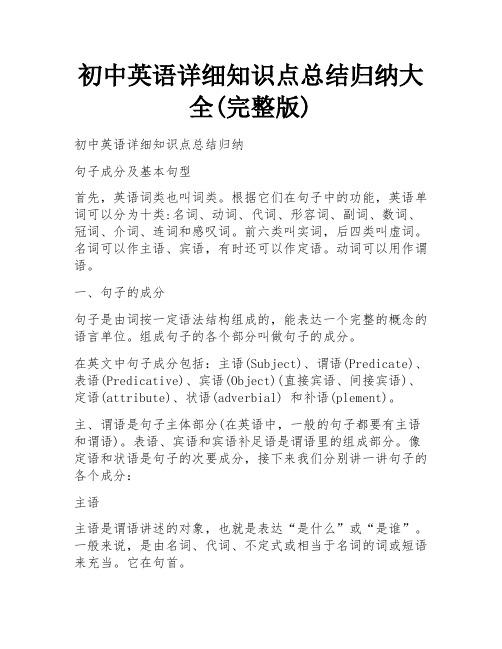
初中英语详细知识点总结归纳大全(完整版)初中英语详细知识点总结归纳句子成分及基本句型首先,英语词类也叫词类。
根据它们在句子中的功能,英语单词可以分为十类:名词、动词、代词、形容词、副词、数词、冠词、介词、连词和感叹词。
前六类叫实词,后四类叫虚词。
名词可以作主语、宾语,有时还可以作定语。
动词可以用作谓语。
一、句子的成分句子是由词按一定语法结构组成的,能表达一个完整的概念的语言单位。
组成句子的各个部分叫做句子的成分。
在英文中句子成分包括:主语(Subject)、谓语(Predicate)、表语(Predicative)、宾语(Object)(直接宾语、间接宾语)、定语(attribute)、状语(adverbial) 和补语(plement)。
主、谓语是句子主体部分(在英语中,一般的句子都要有主语和谓语)。
表语、宾语和宾语补足语是谓语里的组成部分。
像定语和状语是句子的次要成分,接下来我们分别讲一讲句子的各个成分:主语主语是谓语讲述的对象,也就是表达“是什么”或“是谁”。
一般来说,是由名词、代词、不定式或相当于名词的词或短语来充当。
它在句首。
Lucy is a beautiful nurse. (名词作主语)He reads newspapers every day. (代词作主语)Smoking is harmful to the health. (动名词作主语)To swim in Kunming Lake is a great pleasure.(不定式作主语)What we should do is not yet decided. (主语从句作主语)2、谓语说明主语“是什么”“做什么”或者“怎么样”。
谓语(谓语部分里主要的词)必须用动词。
谓语和主语在人称和数两方面必须一致。
它在主语后面。
His Parents are doctors. (系动词和表语一起作谓语)She looks well.(系动词和表语一起作谓语)We study hard.(实义动词作谓语)We have finished reading the book. (助动词和实义动词一起作谓语)He can speak English. (情态动词和实义动词作谓语)3、表语表语说明主语“是什么”或者“怎么样”,由名词、副词、介词、形容词、不定式及相当于名词或形容词的词或短语来充当。
英语教学法教程主要知识点归纳
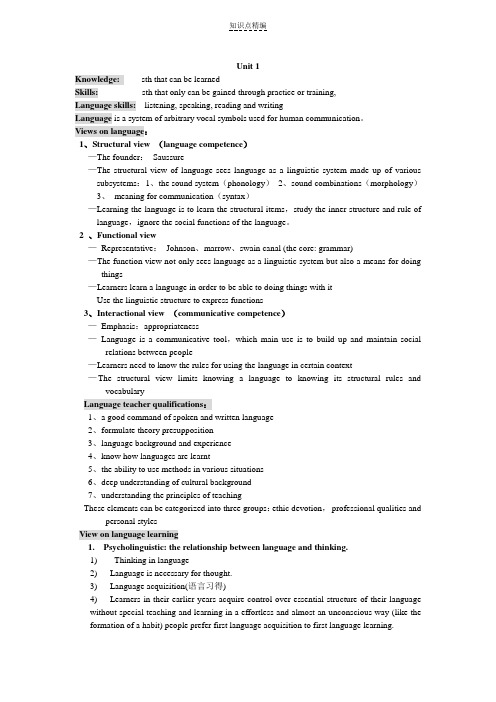
Unit 1Knowledge:sth that can be learnedSkills: sth that only can be gained through practice or training,Language skills:listening, speaking, reading and writingLanguage is a system of arbitrary vocal symbols used for human communication。
Views on language:1、Structural view (language competence)—The founder:Saussure—The structural view of language sees language as a linguistic system made up of various subsystems:1、the sound system(phonology)2、sound combinations(morphology)3、meaning for communication(syntax)—Learning the language is to learn the structural items,study the inner structure and rule of language,ignore the social functions of the language。
2 、Functional view—Representative:Johnson、marrow、swain canal (the core: grammar)—The function view not only sees language as a linguistic system but also a means for doing things—Learners learn a language in order to be able to doing things with itUse the linguistic structure to express functions3、Interactional view (communicative competence)—Emphasis:appropriateness—Language is a communicative tool,which main use is to build up and maintain social relations between people—Learners need to know the rules for using the language in certain context—The structural view limits knowing a language to knowing its structural rules and vocabularyLanguage teacher qualifications:1、a good command of spoken and written language2、formulate theory presupposition3、language background and experience4、know how languages are learnt5、the ability to use methods in various situations6、deep understanding of cultural background7、understanding the principles of teachingThese elements can be categorized into three groups:ethic devotion,professional qualities and personal stylesView on language learning1. Psycholinguistic: the relationship between language and thinking.1)Thinking in language2)Language is necessary for thought.3)Language acquisition(语言习得)4)Learners in their earlier years acquire control over essential structure of their languagewithout special teaching and learning in a effortless and almost an unconscious way (like the formation of a habit) people prefer first language acquisition to first language learning.2.Cognitive theory: the rule for people to aware to cognize sth.Cognitive processes:Process: input----absorb----outputLanguage learning is not just stimulate-reflection, but the using of our subjective capabilities, the using of our cognitive ability to think the language and studying it actively.3. Constructivist theory: learning is a process of meaning construction based on learner’s own knowledge and experience.S ----------AT------------R(刺激) (反应)Stimulus: assimilatio n ①and accommodatio n②①把外部知识纳入自身②纳入自身后也不相符,就要对原有知识进行改变,也就是一种原有知道和外部知识保持联系的创新的过程。
(人教版新目标)八年级英语上册全册各单元知识点期末总复习讲解教学课件

3. feel like “感受到;摸起来”,后跟宾语 从句或名词。 I felt like I was a bird. 我感觉我是一只鸟。 It feels like a stone. 它摸起来像一块石头。
eg.something special; somewhere wonderful. 2.不定代词做主语时,谓语动词用第三人称单数。 eg.Is everybody here? 大家都到齐了吗?
1. get to/reach/arrive 都是“到达“的意思。
get to+sp=reach+sp = arrive at+sp(小)=arrive in+sp(大) 若他们后面要加地点副词here, there, home等,则 不需要加介词。
25、up and down上上下下 26、come up出来 27、enjoy oneself=have fun=have a good time
玩的开心
二、重要句子(语法):
1.Where did you go on vacation? 你到哪里去度假了?
I went to New York City. 我去了纽约城。
三、习惯用法、搭配
1. buy sth. for ab./ buy sb. sth. 为某人买某物 2. taste + adj. 尝起来…… 3. nothing to do but do除了……之外无事可干 4. seem + (to be) + adj 看起来 5. arrive in + 大地方 / arrive at + 小地方 到达某地 6. decide to do sth=make a decision决定做某事 7. try doing sth. 尝试做某事
最全初中英语语法之现在完成时和过去完成时教案

最全初中英语语法之-现在完成时和过去完成时教案一、教学目标1. 让学生掌握现在完成时和过去完成时的构成和用法。
2. 培养学生运用现在完成时和过去完成时进行交际的能力。
3. 提高学生对英语语法的兴趣和自信心。
二、教学内容1. 现在完成时的构成:have/has + 过去分词2. 现在完成时的用法:表示动作发生在过去,对现在有影响或结果。
3. 过去完成时的构成:had + 过去分词4. 过去完成时的用法:表示在过去某个时间点之前已经完成的动作。
三、教学重点与难点1. 重点:现在完成时和过去完成时的构成和用法。
2. 难点:区分现在完成时和一般过去时的区别。
四、教学方法1. 任务型教学法:通过小组活动和任务完成,激发学生的参与和合作意识。
2. 情境教学法:创设真实的语境,让学生在实际情境中运用语法知识。
3. 互动式教学法:教师与学生之间的问答和讨论,促进学生的思考和表达。
五、教学步骤1. 导入:通过图片或故事引入现在完成时和过去完成时的概念。
2. 讲解:讲解现在完成时和过去完成时的构成和用法。
3. 练习:进行现在完成时和过去完成时的填空练习。
4. 任务:分组完成任务,运用现在完成时和过去完成时进行交流。
5. 总结:归纳现在完成时和过去完成时的用法和区别。
六、课后作业1. 完成课后练习题,巩固现在完成时和过去完成时的知识。
2. 设计一个情境,与同学互相练习运用现在完成时和过去完成时进行交流。
七、教学评价1. 课堂参与度:观察学生在课堂上的发言和参与情况。
2. 练习完成情况:检查学生练习题的完成质量。
3. 情境交流:评估学生在情境中的语言运用能力和合作精神。
八、教学资源1. PPT:展示现在完成时和过去完成时的例句和练习。
2. 图片或故事:用于导入和创设情境。
3. 练习题:巩固学生对现在完成时和过去完成时的理解。
九、教学时间1课时(40分钟)十、教学拓展1. 对比现在完成时和一般过去时的用法,进行进一步的练习和讨论。
英语教学法教程主要知识点归纳
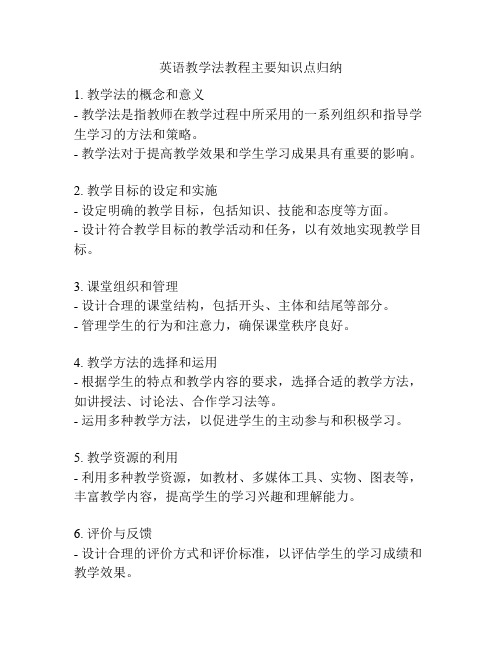
英语教学法教程主要知识点归纳
1. 教学法的概念和意义
- 教学法是指教师在教学过程中所采用的一系列组织和指导学生学习的方法和策略。
- 教学法对于提高教学效果和学生学习成果具有重要的影响。
2. 教学目标的设定和实施
- 设定明确的教学目标,包括知识、技能和态度等方面。
- 设计符合教学目标的教学活动和任务,以有效地实现教学目标。
3. 课堂组织和管理
- 设计合理的课堂结构,包括开头、主体和结尾等部分。
- 管理学生的行为和注意力,确保课堂秩序良好。
4. 教学方法的选择和运用
- 根据学生的特点和教学内容的要求,选择合适的教学方法,如讲授法、讨论法、合作学习法等。
- 运用多种教学方法,以促进学生的主动参与和积极学习。
5. 教学资源的利用
- 利用多种教学资源,如教材、多媒体工具、实物、图表等,丰富教学内容,提高学生的学习兴趣和理解能力。
6. 评价与反馈
- 设计合理的评价方式和评价标准,以评估学生的学习成绩和教学效果。
- 及时给予学生反馈,帮助他们纠正错误和进一步提高。
7. 多元化的教学策略
- 采用多种教学策略,如激发学生的兴趣和好奇心、引导学生
主动探究、启发学生的创造思维等,以提高教学效果。
8. 教学过程的设计和调整
- 设计完整的教学过程,包括课前导入、知识讲解、练习与巩固、课后复习等环节。
- 随时根据学生的学习情况和实际需要,调整教学过程和方法,以提高学习效果。
英语教学法教程主要知识点归纳
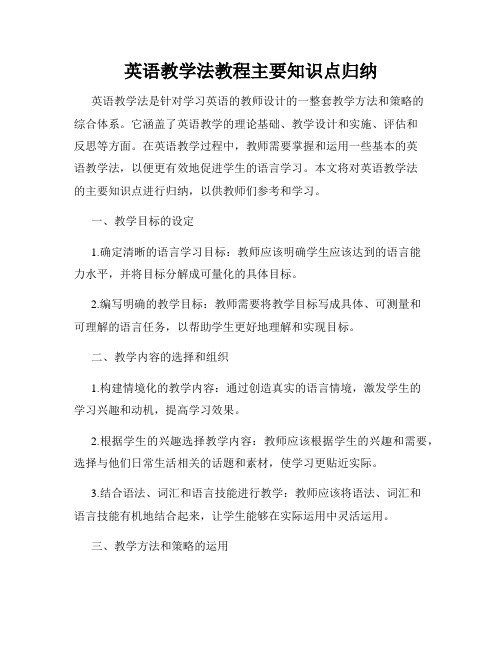
英语教学法教程主要知识点归纳英语教学法是针对学习英语的教师设计的一整套教学方法和策略的综合体系。
它涵盖了英语教学的理论基础、教学设计和实施、评估和反思等方面。
在英语教学过程中,教师需要掌握和运用一些基本的英语教学法,以便更有效地促进学生的语言学习。
本文将对英语教学法的主要知识点进行归纳,以供教师们参考和学习。
一、教学目标的设定1.确定清晰的语言学习目标:教师应该明确学生应该达到的语言能力水平,并将目标分解成可量化的具体目标。
2.编写明确的教学目标:教师需要将教学目标写成具体、可测量和可理解的语言任务,以帮助学生更好地理解和实现目标。
二、教学内容的选择和组织1.构建情境化的教学内容:通过创造真实的语言情境,激发学生的学习兴趣和动机,提高学习效果。
2.根据学生的兴趣选择教学内容:教师应该根据学生的兴趣和需要,选择与他们日常生活相关的话题和素材,使学习更贴近实际。
3.结合语法、词汇和语言技能进行教学:教师应该将语法、词汇和语言技能有机地结合起来,让学生能够在实际运用中灵活运用。
三、教学方法和策略的运用1.交互型教学方法:包括师生互动、学生间互动和学生自主学习,通过口语对话和实践活动培养学生的听说能力。
2.任务型教学方法:通过设置具体的任务来激发学生的学习兴趣和动力,培养学生的语言运用能力。
3.多媒体辅助教学:结合音频、视频和网络资源,提供多样化的教学材料和活动,增强学生的学习体验和参与度。
四、教学评估与反思1.形成性评价:通过课堂观察、作业评查和小组讨论等形式对学生进行及时的反馈和评估,帮助他们发现自己的差距并采取相应的学习策略。
2.总结性评价:通过考试、测验或教育性评估工具对学生的学习成果进行系统的评估,同时为教师提供改进教学的反馈。
五、教学环境的创设1.积极、鼓励的教学氛围:创造友好、开放、尊重和包容的教学环境,鼓励学生参与和表达,培养积极的学习态度。
2.多样化的学习资源:提供丰富多样的教学资源,包括教材、课外读物、在线学习平台等,满足学生的不同学习需求。
七年级英语语法知识点归纳整理

七年级英语语法知识点归纳整理对初中学生的指导更多的应侧重于学习方法和学习意志品质的培养进入初中以后,学生在学习上的独立性逐步增强。
课堂教学中,教师比较注意启发学生独立思考问题;课堂教学外,学生更多的需要自觉地独立安排自己的学习活动。
接下来是小编为大家整理的七年级英语语法知识点归纳整理,希望大家喜欢!七年级英语语法知识点归纳整理一【重点句子】1.How many colours do you see? 你能看见多少种颜色?how many+可数名词复数, 含有how many的特殊疑问句,要用数词来回答。
如:—How many markers do you have? 你有多少枝水彩笔? —I have ten. 我有十枝。
/----Just one. 只有一个。
2. My skirt is very old. Can I get a new one? 我的裙子很旧了,我能买一条新的吗?one在这里是代词,代替前面的skirt.英语中,为了避免重复,常用one代替上文中已出现过的同一类人或物。
Eg: I have a nice sweater. Do you want one? 我有一件漂亮的毛衣。
你想要一件吗?3. What’s your favourite colour? 你最喜欢的颜色是什么?What’s your favourite…?是询问“你最喜欢的??是什么?”的交际用语,其答语是:My favourite ....is…如:---What are your favourite clothes? 你最喜欢的衣服是什么?---My favourite clothes are blouse and skirts. 我最喜欢的衣服是衬衫和连衣裙。
—What’s your favourite sport? 你最喜欢的运动是什么?—My favourite sport is Ping-pong. 我最喜欢的运动是乒乓球。
英语教学法教程主要知识点归纳
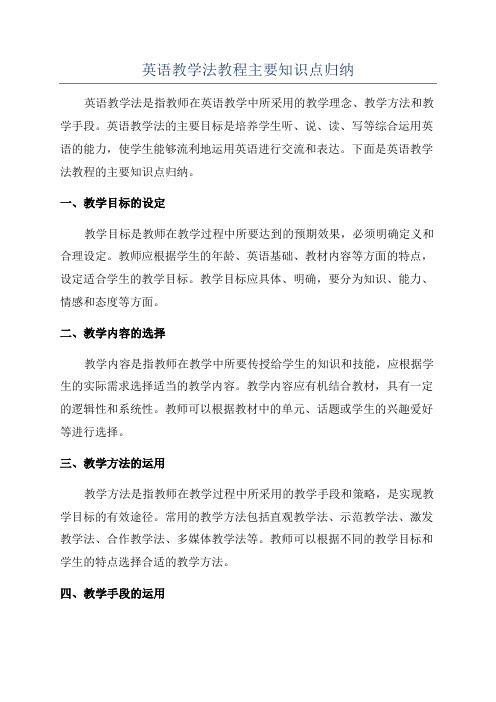
英语教学法教程主要知识点归纳英语教学法是指教师在英语教学中所采用的教学理念、教学方法和教学手段。
英语教学法的主要目标是培养学生听、说、读、写等综合运用英语的能力,使学生能够流利地运用英语进行交流和表达。
下面是英语教学法教程的主要知识点归纳。
一、教学目标的设定教学目标是教师在教学过程中所要达到的预期效果,必须明确定义和合理设定。
教师应根据学生的年龄、英语基础、教材内容等方面的特点,设定适合学生的教学目标。
教学目标应具体、明确,要分为知识、能力、情感和态度等方面。
二、教学内容的选择教学内容是指教师在教学中所要传授给学生的知识和技能,应根据学生的实际需求选择适当的教学内容。
教学内容应有机结合教材,具有一定的逻辑性和系统性。
教师可以根据教材中的单元、话题或学生的兴趣爱好等进行选择。
三、教学方法的运用教学方法是指教师在教学过程中所采用的教学手段和策略,是实现教学目标的有效途径。
常用的教学方法包括直观教学法、示范教学法、激发教学法、合作教学法、多媒体教学法等。
教师可以根据不同的教学目标和学生的特点选择合适的教学方法。
四、教学手段的运用教学手段是指教师在教学中所使用的具体工具和材料,有助于提高学生的学习效果和学习兴趣。
教学手段包括教学用具、多媒体设备、实物、图片、录音、录像等。
教师可以根据教学内容和学生的学习需求选择合适的教学手段。
五、教学评价的方法教学评价是指教师对学生学习情况和教学效果进行评估和判断的过程。
教学评价应注重全面、准确、客观和具体。
常用的教学评价方法包括测试、作业、观察、讨论、听说读写等。
教师可以根据教学目标和学生的实际情况选择合适的教学评价方法。
六、教学设计的步骤教学设计是指教师根据教学目标和教学要求所制定的教学过程和教学计划。
教学设计应包括教学目标、教学内容、教学方法、教学手段、教学评价等方面的内容。
教学设计的步骤包括分析教学内容和学生的学习需求、确定教学目标、设计教学过程和制定教学计划。
深圳初中英语知识点总结
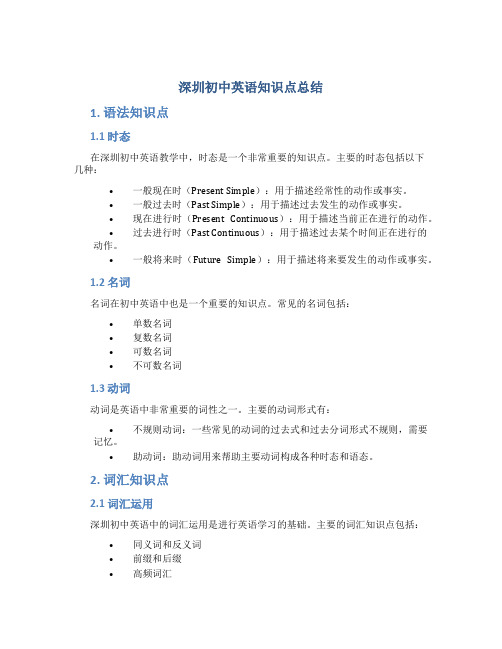
深圳初中英语知识点总结1. 语法知识点1.1 时态在深圳初中英语教学中,时态是一个非常重要的知识点。
主要的时态包括以下几种:•一般现在时(Present Simple):用于描述经常性的动作或事实。
•一般过去时(Past Simple):用于描述过去发生的动作或事实。
•现在进行时(Present Continuous):用于描述当前正在进行的动作。
•过去进行时(Past Continuous):用于描述过去某个时间正在进行的动作。
•一般将来时(Future Simple):用于描述将来要发生的动作或事实。
1.2 名词名词在初中英语中也是一个重要的知识点。
常见的名词包括:•单数名词•复数名词•可数名词•不可数名词1.3 动词动词是英语中非常重要的词性之一。
主要的动词形式有:•不规则动词:一些常见的动词的过去式和过去分词形式不规则,需要记忆。
•助动词:助动词用来帮助主要动词构成各种时态和语态。
2. 词汇知识点2.1 词汇运用深圳初中英语中的词汇运用是进行英语学习的基础。
主要的词汇知识点包括:•同义词和反义词•前缀和后缀•高频词汇2.2 词汇扩展在初中英语中,要提高词汇水平,需要进行词汇扩展。
常见的扩展方式包括:•同义词的扩展•词根词缀的运用•上下文推断词义3. 阅读理解3.1 阅读理解技巧•预测:通过标题、插图等预测文章的内容。
•略读:快速浏览文章,掌握大意。
•细读:仔细阅读并理解文章的细节。
•推断:基于阅读的内容进行推断。
3.2 阅读策略在初中英语的阅读中,可以采用以下策略:•看标题和插图•预测文章内容•关注关键词•注意上下文指代•掌握词汇量4. 写作技巧4.1 写作结构•开头:引入文章主题,概括要写的内容。
•主体:分段叙述,每段一个主题,逐个展开。
•结尾:总结文章内容,表达自己的观点或建议。
4.2 写作表达•使用连接词和过渡词,使文章结构更加紧密。
•使用具体的描述词汇,使文章更加生动。
•使用正确的语法和语句结构,避免错误和歧义。
Unit4 教材分析、教学设想、重要知识点及语法解析2021-2022学年人教版九年级英语全册

Unit4 I used to be afraid of the dark.教材分析、教学设想、重要知识点及语法解析单元教材分析本单元以“我们怎样改变(how we have changed)”为核心话题,在四年后老朋友见面的情景中,围绕本单元语言交际功能项目“谈论你过去是什么样”(talk about what you used to be like),逐步展开各项听、说、读、写活动,给人们一种有趣的体验和新鲜的感受。
教学从谈论人物过去的外貌、性格,进一步延伸到谈论人物过去的心理感受,以及人物过去的爱好等,最后延伸到谈论现在的变化,将过去和现在教学进行对比。
本单元在各项语言活动中,融入大量含used to结构的语句,由于教学内容与学生的实际生活密切相关,易于激发学生学习兴趣。
通过观察图片、听说训练、阅读理解等训练方式和独立学习、合作交流、完成任务等形式完成目标语言的输入,让学生在感受、理解、体验的基础上,很容易就能掌握这个结构。
并能运用used to do sth结构谈论自己与过去的不同,准确地描述人物过得外貌、性格和心理特征。
通过学习,让学生在交际活动中,学会正确地用英语谈论事物的发展和变化,明白事物是在不断发展变化的,培养学生积极向上的健康心态。
Section A:是基本认知部分。
主要介绍单元基本的语言内容,注重学生的听说能力和短语的积累。
教材通过学习描述人物外貌和性格的形容词,利用图片设置的情景导入本单元语言功能项目“谈论你过去是什么样”(talk about what you used to be like)和语法项目“used to”结构,然后通过听力和口语训练逐步落实这些语言功能项目。
活动1a介绍描述人物外貌和性格的重要词汇和used to句型。
让学生理解表格中的词汇,学习用其它的形容词描述人物的外貌和性格,并填在表格中。
利用描述图片上人物或班级内的同学,导入新的语言功能项目,学习used to句型。
初中英语语法易错知识点总结教学内容

初中英语语法易错知识点总结初中英语语法易错知识点总结一.动词be(is,am,are)的用法我(I)用am, 你(you)用are,is跟着他(he),她(she),它(it)。
单数名词用is,复数名词全用are。
变否定,更容易,be后not加上去。
变疑问,往前提,句末问号莫丢弃。
还有一条须注意,句首大写莫忘记。
二.this,that和it用法(1)this和that是指示代词,it是人称代词。
(2)距离说话人近的人或物用this, 距离说话人远的人或物用that。
如:This is a flower. 这是一朵花。
(近处)That is a tree. 那是一棵树。
(远处)(3)放在一起的两样东西,先说this, 后说that。
如:This is a pen. That is a pencil. 这是一支钢笔。
那是一支铅笔。
(4)向别人介绍某人时说This is…, 不说That is…。
如:This is Helen. Helen, this is Tom. 这是海伦,海伦,这是汤姆。
(5)This is 不能缩写, 而That is可以缩写。
如:This is a bike. That’s a car. 这是一辆自行车。
那是一辆轿车。
(6)打电话时,介绍自己用this, 询问对方用that。
如:—Hello! Is that Miss Green? 喂,是格林小姐吗?—Yes, this is. Who’s that? 是的,我是,你是谁?注意:虽然汉语中使用“我”和“你”,但英语中打电话时绝不可以说:I am…, Are you…?/Who are you?(7)在回答this或that作主语的疑问句时, 要用it代替this或that。
如:①—Is this a notebook? 这是笔记本吗?—Yes, it is. 是的,它是。
②—What’s that? 那是什么?—It’s a kite. 是只风筝。
七年级英语上册人教版Unit1YouandMe教学设计

3.教师指导:教师为学生提供练习题,引导学生独立完成。在学生完成后,教师进行讲解和解答,确保学生掌握所学知识。
(五)总结归纳
1.教学内容:教师对本节课所学内容进行总结,巩固学生的记忆。
2.教学方法:采用提问、复述、总结等方式,帮助学生梳理知识点,形成知识体系。
(目的:巩固词汇,提高学生的词汇量)
2.口语练习:学生与家长进行英语口语练习,用一般现在时介绍自己的家庭成员、学校和兴趣爱好。家长录制视频,学生将视频提交给老师。
(目的:提高学生的口语表达能力,增进家校互动)
3.语法练习:完成课后练习册中与本节课相关的语法练习题,包括填空、选择、改错等,要求学生在规定时间内独立完成。
2.分层教学,关注个体差异:针对不同水平的学生,设计难易适度的任务和活动,使每个学生都能在原有基础上得到提高。
3.任务型教学法:设计各种真实、有趣的课堂任务,引导学生积极参与,培养他们的实践能力和合作精神。
4.拓展阅读,提高理解能力:精选与单元主题相关的文章,引导学生进行拓展阅读,提高阅读理解能力。同时,注重培养学生的阅读策略,如略读、寻读、精读等。
5.学生对于与生活密切相关的主题感兴趣,本章节以“你和我”为主题,贴近学生生活,有利于激发学生的学习兴趣和参与度。
在此基础上,教师应结合学生的实际情况,运用多样化的教学策略,注重个体差异,激发学生的学习兴趣和潜能,帮助他们建立自信,培养良好的学习习惯,为今后的英语学习打下坚实基础。
三、教学重难点和教学设想
5.个性化教学:关注学生个体差异,因材施教,满足不同学生的学习需求。
(三)情感态度与价值观
在本章节的学习过程中,教师将关注学生的情感态度与价值观的培养:
深圳初中英语与知识点总结

深圳初中英语与知识点总结深圳初中英语教学大纲与知识点总结一、教学目标深圳初中英语课程旨在培养学生的英语听、说、读、写四项基本技能,同时加强语言知识的学习,提高学生的跨文化交际能力。
通过系统的学习和实践,使学生能够在日常生活、学习和社会交往中有效使用英语。
二、教学内容1. 词汇与短语- 基础词汇:涵盖日常生活、学习、娱乐等方面的基本词汇。
- 短语动词:理解和运用常见的短语动词,如“look after”、“take off”等。
- 习语与搭配:掌握一定数量的英语习语和固定搭配,如“make progress”、“in my opinion”等。
2. 语法知识- 时态:一般现在时、一般过去时、现在进行时、过去进行时、一般将来时、现在完成时等。
- 语态:被动语态的使用及其基本结构。
- 非谓语动词:动名词、分词(现在分词和过去分词)的构成和用法。
- 句型结构:简单句、并列句、复合句(包括定语从句、状语从句、宾语从句等)。
3. 阅读理解- 快速阅读:培养学生快速获取文章大意的能力。
- 细读理解:提高学生对文章细节的理解和分析能力。
- 推理判断:训练学生根据文章内容进行逻辑推理和判断。
4. 写作技巧- 句式多样性:使用不同类型的句子结构,如简单句、并列句和复合句。
- 段落结构:掌握段落的基本结构,包括主题句、支持句和结论句。
- 写作类型:练习不同类型的写作,如记叙文、说明文、议论文和应用文。
5. 听力与口语- 听力理解:通过对话、短文、新闻等多种听力材料,提高学生的听力理解能力。
- 发音准确:注重发音训练,提高学生的英语发音准确性。
- 口语表达:鼓励学生参与角色扮演、讨论等活动,提高口语交际能力。
三、教学方法1. 互动教学:通过小组讨论、合作学习等方式,激发学生的学习兴趣和参与度。
2. 多媒体辅助:利用视频、音频、PPT等多媒体工具,丰富教学内容,提高教学效果。
3. 任务型教学:设计贴近学生生活实际的任务,让学生在完成任务的过程中学习和使用英语。
最新《英语教学法教程》主要知识点归纳
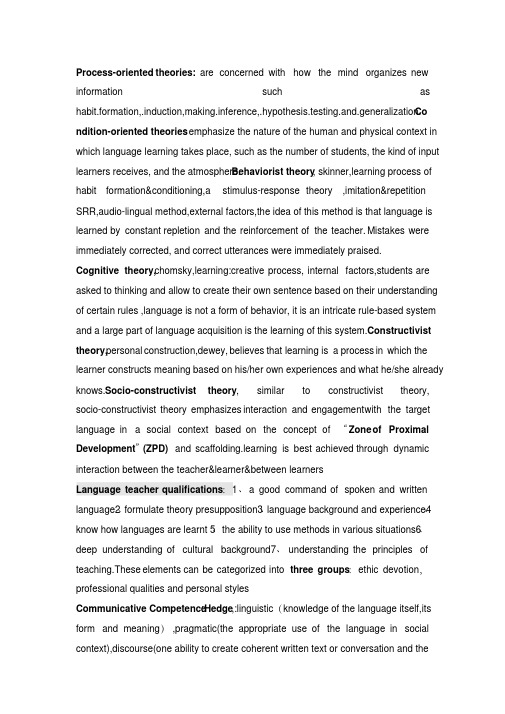
Process-oriented theories: are concerned with how the mind organizes new information such ashabit.formation,.induction,making.inference,.hypothesis.testing.and.generalization.Condition-oriented theories: emphasize the nature of the human and physical context in which language learning takes place, such as the number of students, the kind of inputlearners receives, and the atmosphere.Behaviorist theory, skinner,learning process of habit formation&conditioning,a stimulus-response theory ,imitation&repetitionSRR,audio-lingual method,external factors,the idea of this method is that language is learned by constant repletion and the reinforcement of the teacher. Mistakes wereimmediately corrected, and correct utterances were immediately praised.Cognitive theory,chomsky,learning:creative process, internal factors,students areasked to thinking and allow to create their own sentence based on their understandingof certain rules ,language is not a form of behavior, it is an intricate rule-based system and a large part of language acquisition is the learning of this system.Constructivisttheory,personal construction,dewey, believes that learning is a process in which the learner constructs meaning based on his/her own experiences and what he/she alreadyknows.Socio-constructivist theory, similar to constructivist theory, socio-constructivist theory emphasizes interaction and engagement w ith the targetlanguage in a social context based on the concept of “Zone of Proximal (ZPD) and scaffolding.learning is best achieved through dynamic Development” interaction between the teacher&learner&between learnersLanguage teacher qualifications:1、a good command of spoken and written language2、formulate theory presupposition3、language background and experience4、know how languages are learnt 5、the ability to use methods in various situations6、deep understanding of cultural background7、understanding the principles of teaching.These elements can be categorized into three groups:ethic devotion,professional qualities and personal stylesCommunicative Competence:Hedge,:linguistic(knowledge of the language itself,itsform and meaning),pragmatic(the appropriate use of the language in social context),discourse(one ability to create coherent written text or conversation and theability to understand it) ,strategic(strategies one employs when there is communication breakdown due to lack of resource),fluency(ability to link units of speech together with facility and without strain or inappropriate to slowness or undue hesitation)Views on language.Structural view —The founder:Saussure—The structural view:1、of language sees language as a linguistic system made up of various subsystems the sound system(phonology)2、sound combinations(morphology)3、meaning for communication(syntax)—Learning the language is to learn the structural items,study the inner structure and rule of language,ignore the social functions of the language。
英语知识点-七年级英语上教案全集湘教版【精选教案】
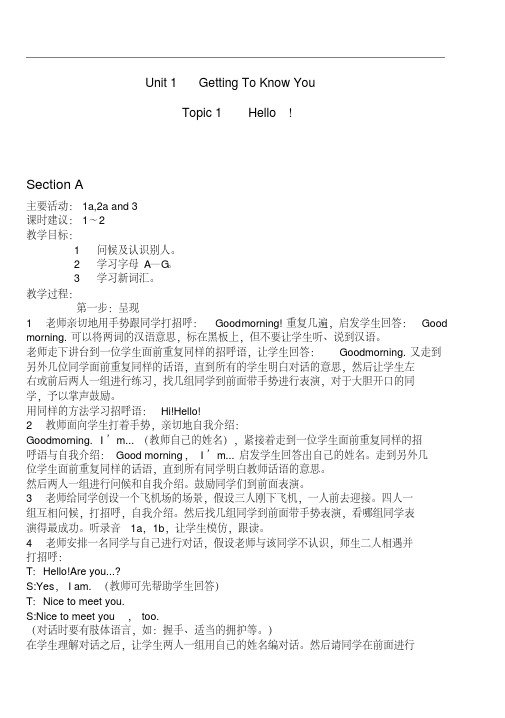
Unit 1 Getting To Know YouTopic 1 Hello!Section A主要活动:1a,2a and 3课时建议:1~2教学目标:1问候及认识别人。
2学习字母A—G。
3学习新词汇。
教学过程:第一步:呈现1老师亲切地用手势跟同学打招呼:Good m orning!重复几遍,启发学生回答:Good morning.可以将两词的汉语意思,标在黑板上,但不要让学生听、说到汉语。
老师走下讲台到一位学生面前重复同样的招呼语,让学生回答:Good m orning.又走到另外几位同学面前重复同样的话语,直到所有的学生明白对话的意思,然后让学生左右或前后两人一组进行练习,找几组同学到前面带手势进行表演,对于大胆开口的同学,予以掌声鼓励。
用同样的方法学习招呼语:Hi!Hello!2教师面向学生打着手势,亲切地自我介绍:Good m orning. I’m...(教师自己的姓名),紧接着走到一位学生面前重复同样的招呼语与自我介绍:Good morning,I’m...启发学生回答出自己的姓名。
走到另外几位学生面前重复同样的话语,直到所有同学明白教师话语的意思。
然后两人一组进行问候和自我介绍。
鼓励同学们到前面表演。
3老师给同学创设一个飞机场的场景,假设三人刚下飞机,一人前去迎接。
四人一组互相问候,打招呼,自我介绍。
然后找几组同学到前面带手势表演,看哪组同学表演得最成功。
听录音1a,1b,让学生模仿,跟读。
4老师安排一名同学与自己进行对话,假设老师与该同学不认识,师生二人相遇并打招呼:T:Hello!Are you...?S:Yes, I am.(教师可先帮助学生回答)T:Nice to meet you.S:Nice to meet you, too.(对话时要有肢体语言,如:握手、适当的拥护等。
)在学生理解对话之后,让学生两人一组用自己的姓名编对话。
然后请同学在前面进行。
- 1、下载文档前请自行甄别文档内容的完整性,平台不提供额外的编辑、内容补充、找答案等附加服务。
- 2、"仅部分预览"的文档,不可在线预览部分如存在完整性等问题,可反馈申请退款(可完整预览的文档不适用该条件!)。
- 3、如文档侵犯您的权益,请联系客服反馈,我们会尽快为您处理(人工客服工作时间:9:00-18:30)。
What makes a good qualified english teacher?A plan of given material.1 CLT :Communicative Language Teaching2 TBLT:Task-based Language Teaching3 PPP:Presentation,Practice and Production. 3P教学法4 Macro Planning 宏观计划It plans over a longer period of time,for instance, planning for a whole programme or a whole-year course.6 Micro planning 微观计划It plans for a specific unit or a lesson, which usually lasts from one to two weeks or forty to fifty minutes respectively.7 The guided discovery method 指导发现法It is similar to the inductive method in that the students are induced to discover rules by themselves but different in that the process of the discovery is carefully guided and assisted by the teacher and the rules are then elicited and taught explicitly.8 Implicit knowledgeIt refers to knowledge that unconsciously exists in our mind,which we can make use of automatically without making any effort.9 Explicit KnowledgeIt refers to our conscious knowledge about the language.10 Bottom-up model 自上而下/文本驱动模式The way teaches reading always reflects the way one understands reading and the reading process.11 Top-down model 图示驱动模式One's background knowledge plays a more important role than new words and new structures in reading comprehension.12 Interactive model 交互模式The current theory views reading as an interactive process. That is to say,the brain receives visual information and at the same time, interprets or reconstructs the meaning the writer had in mind when he wrote the text.13 AssessmentIt involves the collecting of information or evidence of a leaner's learning progress and achievement over a period of time for the purposes of improving teaching and learning.14 Sight V ocabulary 即识词汇Words that one is able to recognise immediately are often referred to as sight vocabulary.In other words, your sight vocabulary will be those words that you can recognise with both sounds and meanings without special effort from your brain.15 Information Gap信息沟16 Portfolio学习文件夹成长记录袋It is a purposeful collection of materials assembled over a period of time by a learner to provide evidence of skills,abilities and attitudes related to their study.17 Mechanical PracticeIt involves activities that are aimed at form accuracy.18 Meaningful PracticeIt focus on the production,comprehension or exchange of meaning though the students ' keep an eye on ' the way newly learned structures are used in the process.19 Criterion-referenced assessmentCriterion-referenced language assessment is based on a fixed standard or a set criterion.20 Norm-referenced assessmentIt is designed to measure how the performance of a particular student or group of students compares with the performance of another students or group of students whose scores are given as the norm.21 On -the-use evaluationIt means the evaluation which is carried out independent of its users or before it gets into the classroom.22 In-the-use evaluationFor in-the-use evaluation,evaluation is done based on the user's opinions about how useful and effective it is for promoting learning.1 What is the communicative competence?It includes both the knowledge about the language and the knowledge about how to use the language appropriately in communicative situations.2 Principles of CLTmunicative principle:Actives that involve real communication promote learning.B.Task principle:Activities in which language is used for carrying out meaningful tasks promote learning.C. Meaningfulness principle: language that is meaningful to the learner supports the learning process.3 The 6 orientation for evaluating the communicative classroom acting.A. Communicative purpose:The activity must involve the students in performing a real communicative purpose rather than just practising language for its own sake. 目的B. Communicative desire:The activity must create a desire to communicate in the students. 交际欲望C. Content,not form:When the students are doing the activity, they must be concentrating on what they are saying,not how they say it.有内容,不是考虑形式D. Variety of language: The activity must involve the students in using a variety of language,not just one specific language form.E. No teacher intervention:The activity must be designed to be done by the students working by themselves rather than with the teacher.干涉F. No materials control: The activity should not be designed to control what language the students should use.4 Four components of the taskA. A purpose: making sure the students have a reason for undertaking the taskB. A contact: this can be real,simulated or imaginary,and involves sociolinguistic issues such as the location, the participants and their relationship,the time,and other important factorsC. A process:getting the students to use learning strategies such as problem solving reasoning,inquiring, conceptualising and communicating.D. A product: there will be some form of outcome, either visible or invisible.5 Principles for good lesson planningA. Aim. It means the realistic goals for the lesson.B. Variety. It means planning a number of different types of activities and where possible,introducing students to a wide selection of materials so that learning is always interesting,motivating and never monotonous for the students.C. Flexibility. It means preparing some extra and alternative tasks and activities so that teachers have the options to cope with the unexpected situations rather than being the slaves of written plans or one methodology.D. Learnability. It means the contents and tasks planned for the lesson should be within the learning capability of the students.E. Linkage. It means the stages and steps within each stage are planned in such a way that they are someway linked with one another.6 Measures for indisciplined actsA. Act immediately. If possible, indisciplined acts should be immediately stopped so that less damage is made.B. Stop the class. If the indiscipline hinder the progress of the whole class, the teacher should stop the class and make it clear what is wrong.C. Rearrange the seats. If students are moved to the front of the class they will behave better.D. Change the activity.E. Talk to students after class. If a student is continually making trouble, the teacher should talk to that student after class.F. Create a code of behaviour. It means the teacher and students can work together to create some basic rules for the class during activities.7 How to deal with errorsA. Make a distinction between an error and a mistake. A mistake refers to a performance error that is either a random guess or a ' slip of tongue ', and it is a failure performance to a known system. An error has direct relation with the learners' language competence.B. Dealing with spoken errorsC. Choose proper time to correctD. How to correct. Avoid damaging students' self esteem and confidence.8 Goal of teaching pronunciationA. Consistency:the pronunciation should be smooth and natural.B. Intelligibility:the pronunciation should be understandable to the listeners.C. Communicative efficiency:the pronunciation should help convey the meaning that is intended by the speaker.9 What does it mean to know a word.A. It means knowing its pronunciation and stressB. Knowing its spelling grammatical propertiesC. Knowing its meaningD. Knowing how and when to use it to express the intended meaning.10 Ways of presenting vocabularyA. Try to provide visual or physical demonstration whenever possible, using pictures, photos, video clips, mime or gestures to show meaning.B. Provide a verbal context to demonstrate meaning.C. Use synonyms or antonyms to explain meanings.D. Use lexical sets or hyponyms to show relations of words and their meanings.E. Translate and exemplify,especially with technical words or words with abstracts meaning.F. Use word formation rules and common affixes to build new lexical knowledge on what is already known.G. Teach vocabulary in chunks.H. Think about the context in real life where the word might be used.I. Think about providing different context for introducing new words.J. Prepare for possible misunderstanding or confusion that students may have.11 Principles for teaching speakingA. Balancing accuracy-based with fluency-based practices.B. Contextualising practiceC. Personalising practiceD. Building up confidenceE. Maximising meaningful interactionsF. Helping students develop speaking strategiesG. Making the best use of classroom learning environment to provide sufficient language input and practice for the students12 The main procedures of process writingA. Creating a motivation to writeB. Brainstorming,C. MappingD. FreewritingE. OutliningF. DraftingG.editingH. RevisingI. ProofreadingJ.conferencing13 Methods for assessmentA. Summative and formative assessmentB. Teacher's observationsC. Continuous assessmentD. Self-assessment and peer assessmentE. Project work学习日志F. Portfolios学习文件夹成长记录袋。
